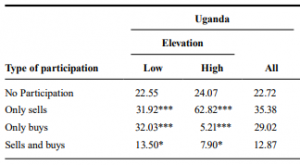27 Queensland University of Technology: Funding a Golden Opportunity
As Alyson Summers and Shawn Baker strolled out of her office, Vidya Vasu-Devan, senior officer in program investment at the Bill and Melinda Gates Foundation, looked down at the information package that Alyson had left on her desk. The global development divisions had identified for the program investment department a novel opportunity with a focus on nutrition for human growth and development.
Alyson and Shawn had called this meeting to discuss the opportunity to invest in a small project affiliated with the Centre for Tropical Crops and Biocommodities(CTCB) run by professor James Dale and the Queensland University of Technology. This lab was seeking funding to develop a new vitamin A-rich banana that aligns with the current global development and nutritional aims of the foundation.
Vidya understood their enthusiasm with this new opportunity but was much more hesitant after years of experience with disappointing investment opportunities to take on this project at first glance. She knows that there were many external factors and internal factors that go into the success of a product and its adoption within its target market. She was also familiar with the past struggles bringing vitamin A-enriched products to market and knows that these social issues could hold back any potential future advancements in these areas.
Vidya had asked the global development division to provide her with an information package on the researchers, the product, and the market for this product to aid in her final funding decision.
Professor James Dale
Professor James Dale was the inaugural director of the CTCB at Queensland University of Technology. This organization consists of approximately 50 researchers, and more than 25 postgraduate students working on projects ranging from gene discovery and genetic modification through to biomass fractionation, processing and value adding in the area of tropical crops(Dale, n.d.). The CTCB has collaborative projects with Syngenta and in Africa, Asia, Europe and the Americas in attempt to grow the global bioeconomy(Institute for Future Environments, n.d.).
Professor Dale has had a hand in biotechnology research for over 30 years with interest in the biofortification of bananas, molecular farming for high-value medical proteins and the development of disease resistance in genetically modified bananas, papaya; and sugar cane(Dale, n.d.). He and his research team. He has led international research and development programs within both South East Asia and the South Pacific with plans to expand international efforts to Africa(Paul et al., 2016). He is an inventor on nine granted patents or applications including the patent for GeneCo technology that was later sold to Affymetrix(Dale, n.d.). He was the founder and chief science officer of Farmacule Bioindustries, Australia’s first molecular farming company that later merged with Aquacarorotene to form the first listed molecular farming company Leaf Energy(Retka Schill, 2012). Lastly, in 2004, James Dale was made an Officer in the Order of Australia (AO) for services to agricultural biotechnology(Dale, n.d.). Within the last 10 years, James Dale has experience bringing genetically modified and biofortified bananas to field trials within both African and Asian countries.
Vitamin A
Vitamin A is a fat-soluble retinoid that is involved in immune function, vision, reproduction and cellular communication(Office of Dietary Supplements, n.d.). Vitamin A is critical for vision and the development of function within the eye. Vitamin A has also been linked to cell growth and differentiation in the heart, lungs, kidneys, and other organs proving essential in the growth and development of a human child (Ross, 2006). Vitamin A is available in the diet in two different forms, preformed vitamin A (retinol) and provitamin A carotenoids (α and β carotene) that are converted into vitamin A by various metabolic processes(Zimmermann & Hurrell, 2002).
The recommended dietary allowance (RDA) is the average daily level of intake sufficient to meet the nutrient requirement of nearly all healthy individuals. The RDA for Vitamin A increases steadily from birth until 14 years of age shown through increasing need for retinol activity equivalents (RAE) (Exhibit 1)(Office of Dietary Supplements, n.d.). RAE accounts for the different bioactivities of retinol and provitamin A within the diet of humans. The main source for provitamin A within a healthy diet is leafy green vegetables, orange and yellow vegetables, tomato products, fruits and some vegetable oils(Klein B. P. & Perry a. K., 2006). Whereas preformed vitamin A is mainly found in milk and eggs(Olson, 1987). Many different foods provide varying levels of vitamin A and a varied diet is important in obtaining an adequate level of vitamin A on a daily basis (Exhibit 2)(Office of Dietary Supplements, n.d.).
Vitamin A Deficiency
Vitamin A deficiency is most common in developing countries because residents have limited access to foods containing vitamin A(Sommer, Hussaini, Tarwotjo, & Susanto, 1983). The World Health Organization has stated that 190 million preschool-aged children and 19.1 million pregnant women have do not receive enough vitamin A(Howson, Kennedy, & Horwitz, 1998). Vitamin A deficiency typically begins at a young age due to lack of vitamin A provided within their diet of breast milk. Chronic diarrhea can develop with vitamin A deficiency which leads to further nutrient loss and a more severe case of vitamin A deficiency(Sommer, Katz, & Tarwotjo, 1984). A common symptom of vitamin A deficiency is an abnormal dryness, and inflammation of the eye that causes the inability to see in low light or darkness(Sommer et al., 1983). Vitamin A deficiency is the leading cause of preventable blindness in children and increases the severity and mortality risk of infections.
Approximately 627,000 children die each year from deaths that could be prevented by vitamin A supplementation(Humphrey, West, & Sommer, 1992). There are 122 countries classified as having a moderate to severe public health problem with vitamin A deficiency in children age 5 and under (Exhibit 3) (WHO, 2009). The countries with the most severe public health issues involving vitamin A deficiency are geographically located within sub-Saharan Africa and South Asia. The countries within sub-Saharan Africa accounts for 61% of the total deaths attributable to vitamin A deficiency (WHO, 2009). Within Uganda alone, 28% of the population aged 6 to 59 months suffers from vitamin A deficiency(Fiedler & Afidra, 2010).
Food Fortification
Food fortification is the public health policy of adding micronutrients to foodstuffs in order to ensure that minimum dietary requirements are met. The East Central and South African (ECSA)- Health Community agreed to the fortification of five staple foods(Exhibit 4 and 5) including the fortification of both sugar and oils with preformed vitamin A(Fiedler & Afidra, 2010). Subsequently, In 2004, the Uganda National Board of standards set the standard of 15mg per kg of oil(Fiedler & Afidra, 2010). Previous food fortification efforts have been directed towards the Asian populations affected by vitamin A deficiency. This effort was directed through a product known as golden rice that upon development received a bad reputation for its GMO nature by several social advocacy groups(Greenpeace, n.d.).
Vegetable Oil Fortification
A study done by Fiedler and Afidra in 2010 reported that in 2007 Uganda imported 285 million metric tons of vegetable oil, 99.6% of which consisted of crude palm oil that was later processed into refined vegetable oil. This palm oil is imported from Malaysia and refined by two major companies, Mukwano and BIDCO. These two companies produced approximately 105,000 metric tons of refined vegetable oil in 2007 and significantly outperformed the other 26 vegetable oil producers in the Ugandan market. These smaller refineries only produce subnational or regional supply and therefore cannot compete with Mukwano and BIDCO on a national level. These two companies produce 85% of the countries output and that is used across the country and exported to surrounding countries. Both facilities have previously expressed a commitment to Vitamin A fortification of vegetable oil(Fiedler & Afidra, 2010).
In this same study they found that in July 2004, Mukwano began voluntary fortification by addition of preformed vitamin A to its vegetable oil products with BIDCO following suit soon after in 2005. In a 2009 study, costs were estimated at US$277,834 for the annual incremental costs of vitamin A fortification with an upfront capital cost of $9,050 for each of these companies. This number can also be viewed as a US$5.29/metric ton increase in price of refined and enriched vegetable oils. Assuming that the cost increases are shifted onto the consumer by price increase, the maximum price increase to cover these costs is 8.02 UGX (US$0.0048). This is the equivalent of 0.26% of the retail price of 1 L of vegetable oil at the price it is sold within Uganda. According to the Uganda National Household Survey, 54% of Ugandan households purchase and consume vegetable oil. It was estimated that the average Ugandan household will pay an additional US$0.163 per year for fortified vegetable oil(Fiedler & Afidra, 2010).
Sugar Fortification
In the Fiedler and Afidra study, they also determined that sugar production in Uganda has increased nearly twofold from 1998 to 2007 resulting in a 232,180-metric ton output of sugar in 2007. This output accounts for 77% of the 25644 metric tons of sugar consumed nationally by the Ugandan population. 83% of the Ugandan sugar output is produced by three mills; Kakira, Kinyara and Lugazi. Two of these companies stated that they did not want to oppose or be seen as opposing something that could improve the health of the Ugandan population, whereas the final company is unequivocally opposed to the fortification of its product with preformed vitamin A. Due to these attitudes it looks as though it will have to be legally mandated before fortification by these companies will be implemented(Fiedler & Afidra, 2010).
This same study estimated that approximately 197,292 metric tons of sugar was produced by the top 4 sugar mills in Uganda. 58% of Uganda’s 5.23 million households purchase sugar with an average consumption around 32.6g/person. The retail price of sugar for the Ugandan population is US$1.02 per kg. The addition of preformed vitamin A would cost approximately US$11.39 per metric ton of sugar to meet the standard previously set for the vegetable oil fortification. Assuming that the cost increases of fortification with preformed vitamin A are shifted onto the consumer by price increase, the maximum price increase to is 18.964 UGX (US$0.01139). This is the equivalent of 1.12% of the retail price of a kilogram of sugar at the price it is sold within Uganda. The average Ugandan household would pay an additional US$0.1355 per year for fortified sugar(Fiedler & Afidra, 2010)
Rice Fortification
Golden Rice had been engineered to contain the genes necessary to produce beta-carotene in the grain. This product was developed by Ingo Potrykus and Peter Beyer originally in 1999. Syngenta scientists were able to enhance the beta-carotene level 23-fold in 2005(Paul et al., 2016). This was done by inserting two genes one from a species of soil bacterium as well as a gene from Erwinia uredovora that was later changed to a gene from maize in 2005 to improve function and overall beta-carotene level(Paul et al., 2016). This level of beta-carotene is enough to cover the recommended daily allowance for children and adults eating a rice-based diet(Tang et al., 2012).
Golden Rice was developed for use in the Philippines, where rice is a staple food eaten with many meals and low levels of vitamin A affect approximately 50% of children aged 1-16 years (Solon, Popkin, Fernandez, & Latham, 1978). However, the release of this product has been hindered by social advocacy groups against the use of GMOs. Greenpeace international has publicly stated in their report that:
I. The exact metabolic pathway for beta-carotene is poorly understood, and overexposure to vitamin A could have negative health benefits.
II. Malnutrition cannot be solved by Golden Rice and should be solved by an increased biodiversity of indigenous vitamin-rich crops and not genetically engineered crops
III. Natural strains of rice could be contaminated with GE rice through seed bank mixing, transport, and cross-pollination increasing the difficulty to eradicate Golden Rice if the need arose.
The Golden Banana
Within Uganda, bananas are the principal staple fruit where consumption levels average 0.5kg per person per day to approximately 1 kg per person per day in some regions(Smale & Tushemereirwe, 2007). In East Africa, the staple banana is the East African highland banana that is prepared primarily by steaming or boiling for meal preparation. Alternatively, in West Africa, plantains are dominant and are usually fried or roasted for meal preparation(Fungo & Pillay, 2011). These bananas are a natural source of beta-carotene (10ug/g) (Mbabazi, 2015). However, they do not contain the levels needed to reach the recommended daily allowance needed to solve vitamin A deficiency within Uganda. The Fe’i bananas of Micronesia and Papua New Guinea contains significantly higher levels of beta-carotene (340ug/g)(Englberger et al., 2006). Due to the low male and female fertility of domesticated bananas, conventional breeding of the Fe’i beta-carotene level into the East African highland banana is extremely difficult(Paul et al., 2016).
The CTCB turned to genetic modification to solve these breeding issues. Due to both the bioconversion of and the typical steaming and boiling processes these bananas go through the genetically modified “Golden Bananas” needed to contain 40ug/g to achieve the daily recommended allowance of vitamin A(Paul et al., 2016). Transgenic cavendish banana’s expressing the banana phytoene synthase gene controlled by the ubiquitin promoter produced a banana with approximately 55.0 ug/g(Paul et al., 2016). The first Ugandan field trial from this program commenced in 2010. In 2012 the program progressed from the research to the development phase after refunding and expanded into India through collaborating with the Indian Department of Biotechnology(QUT).
Banana Market: Uganda
Uganda is one of the worlds largest producers and consumers of bananas; producing approximately 7205 million kg per year(Komarek, 2010). This is not surprising because bananas occupy 38% of all agricultural land in Uganda, and contribute to both household food consumption and labor allocations with approximately 90 percent of Uganda’s banana output consumed within the domestic market(Exhibit 6 and 7)(Smale & Tushemereirwe, 2007). Approximately 65 % of output is consumed on-farm by the producers, while only 35 % is sold to nearby markets and within Kampala. Large market margins exist, with the retail prices in Kampala double those received by farmers with little to no product transformation during this time(Benson Todd, Mugarura Samuel, & Wanda Kelly, 2008). Transport costs are the highest associated marketing cost for the sale of bananas within this market; this accounts for around 80 % of total marketing costs(Smale & Tushemereirwe, 2007).
The adoption of both improved bananas and recommended farming practices have been examined throughout Uganda. It was found that low adoption rates (8.8%) for improved bananas was due to inferior cooking quality of the disease resistant hybrid bananas and the dissemination of products to mainly lowland areas(Smale & Tushemereirwe, 2007). Recommended farming practices are more widely adopted (11.6%-95.6%) with the highest of these adoption rates found near paved roads, showing that access to information and markets is important in the adoption of practices. In the past, these recommended farming practices and improved bananas have been provided by the government to improve public health and economic growth(Smale & Tushemereirwe, 2007).
Opportunity
Currently, vitamin A deficiency poses a significant threat to both African and Asian developing countries where a simple solution has yet to be developed. Vitamin A deficiency affects women and children independent of wealth and affects all economic groups within Uganda(USAID, n.d.)
For the Ugandan Government and the Centre for Tropical Crops and Biocommodities, this presents a unique opportunity to improve the public health of this developing nation. In doing so, these companies must ensure that there is a high enough need for the Golden Banana to warrant the Genetic engineering of a staple food within the Ugandan diet.
Many previous efforts to eradicate vitamin A deficiency within Uganda have proved ineffective due to the cost of adoption of these processes and the negative view of GMO products within global markets. Many individuals and organizations feel that this is a quick fix to the much larger problem of poverty and lack of a varied diet within developing countries(Greenpeace, n.d.). Additionally, organizations in the past have been opposed to the use of GMOs due to the many unknown factors that they pose.
Current Field trials show promise in the growth of Golden Bananas and adoption of these products within the Ugandan market(Dale, n.d.).
The Task
The decision to fund the research behind and the development of a product is a critical task bringing new products to market within the biotechnology industry. This is no easy task, involving deep thought about the many economic, social, political, and technological factors that surround this market and product. Vidya Vasu-Devan knew that this would be no simple decision and that it was time to get to work.
References
Benson Todd, Mugarura Samuel, & Wanda Kelly. (2008). Impacts in Uganda of rising global food prices: the role of diversified staples and limited price transmission. Agricultural Economics, 39(s1), 513–524. https://doi.org/10.1111/j.1574-0862.2008.00356.x
Dale, J. (n.d.). QUT | Staff Profiles | James Dale. Retrieved April 8, 2018, from http://staff.qut.edu.au/staff/dale/
Englberger, L., Schierle, J., Aalbersberg, W., Hofmann, P., Humphries, J., Huang, A., … Fitzgerald, M. H. (2006). Carotenoid and vitamin content of Karat and other Micronesian banana cultivars. International Journal of Food Sciences and Nutrition, 57(5–6), 399–418. https://doi.org/10.1080/09637480600872010
Fiedler, J. L., & Afidra, R. (2010). Vitamin A Fortification in Uganda: Comparing the Feasibility, Coverage, Costs, and Cost-Effectiveness of Fortifying Vegetable Oil and Sugar. Food and Nutrition Bulletin, 31(2), 193–205. https://doi.org/10.1177/156482651003100202
Fungo, R., & Pillay, M. (2011). beta-Carotene content of selected banana genotypes from Uganda. African Journal of Biotechnology, 10(28), 5423–5430.
Greenpeace. (n.d.). Special Report: Golden Rice. Retrieved April 8, 2018, from http://www.greenpeace.org/archive-international/en/campaigns/agriculture/problem/Greenpeace-and-Golden-Rice/
Howson, C. P., Kennedy, E. T., & Horwitz, A. (1998). Prevention of Vitamin A Deficiency. National Academies Press (US). Retrieved from https://www-ncbi-nlm-nih-gov.subzero.lib.uoguelph.ca/books/NBK230106/
Humphrey, J. H., West, K. P., & Sommer, A. (1992). Vitamin A deficiency and attributable mortality among under-5-year-olds. Bulletin of the World Health Organization, 70(2), 225–232.
Institute for Future Environments. (n.d.). Centre for Tropical Crops and Biocommodities [general]. Retrieved April 8, 2018, from https://www.qut.edu.au/institute-for-future-environments/research/research-centres-and-programs/centre-for-tropical-crops-and-biocommodities
Klein B. P., & Perry a. K. (2006). Ascorbic Acid and Vitamin A Activity in Selected Vegetables from Different Geographical Areas of the United States. Journal of Food Science, 47(3), 941–945. https://doi.org/10.1111/j.1365-2621.1982.tb12750.x
Komarek, A. (2010). The determinants of banana market commercialisation in Western Uganda. African Journal of Agricultural Research, 5(9), 775–784.
Mbabazi, R. (2015). Molecular characterisation and carotenoid quantification of pro-vitamin A biofortified genetically modified bananas in Uganda (phd). Queensland University of Technology. Retrieved from https://eprints.qut.edu.au/84853/
Office of Dietary Supplements. (n.d.). Vitamin A. Retrieved April 8, 2018, from https://ods.od.nih.gov/factsheets/VitaminA-HealthProfessional/
Olson, J. A. (1987). Recommended dietary intakes (RDI) of vitamin A in humans. The American Journal of Clinical Nutrition, 45(4), 704–716. https://doi.org/10.1093/ajcn/45.4.704
Paul, J.-Y., Khanna Harjeet, Kleidon Jennifer, Hoang Phuong, Geijskes Jason, Daniells Jeff, … Dale James. (2016). Golden bananas in the field: elevated fruit pro‐vitamin A from the expression of a single banana transgene. Plant Biotechnology Journal, 15(4), 520–532. https://doi.org/10.1111/pbi.12650
Retka Schill, S. (2012, November 27). Australians develop glycerol-based biomass pretreatment process. Retrieved April 8, 2018, from http://www.biodieselmagazine.com/articles/8817/australians-develop-glycerol-based-biomass-pretreatment-process
Ross C.A., “Vitamin A. In: Coates PM, Betz JM, Blackman MR, et al., eds. Encyclopedia of Dietary Supplements. 2nd ed. London and New York: Informa Healthcare; 2010:778-91.
Smale, M., & Tushemereirwe, W. K. (2007). An economic assessment of banana genetic improvement and innovation in the Lake Victoria Region of Uganda and Tanzania: (Research reports No. 155). International Food Policy Research Institute (IFPRI). Retrieved from https://ideas.repec.org/p/fpr/resrep/155.html
Solon, F. S., Popkin, B. M., Fernandez, T. L., & Latham, M. C. (1978). Vitamin A deficiency in the Philippines: a study of xerophthalmia in Cebu. The American Journal of Clinical Nutrition, 31(2), 360–368. https://doi.org/10.1093/ajcn/31.2.360
Sommer, A., Katz, J., & Tarwotjo, I. (1984). Increased risk of respiratory disease and diarrhea in children with preexisting mild vitamin A deficiency. The American Journal of Clinical Nutrition, 40(5), 1090–1095. https://doi.org/10.1093/ajcn/40.5.1090
Sommer, Alfred, Hussaini, G., Tarwotjo, I., & Susanto, D. (1983). Increased mortality in children with mild vitamin A deficiency. The Lancet, 322(8350), 585–588. https://doi.org/10.1016/S0140-6736(83)90677-3
Tang, G., Hu, Y., Yin, S., Wang, Y., Dallal, G. E., Grusak, M. A., & Russell, R. M. (2012). β-Carotene in Golden Rice is as good as β-carotene in oil at providing vitamin A to children. The American Journal of Clinical Nutrition, 96(3), 658–664. https://doi.org/10.3945/ajcn.111.030775
USAID. (n.d.). Uganda: Nutrition Profile. Retrieved April 8, 2018, from https://www.usaid.gov/what-we-do/global-health/nutrition/countries/uganda-nutrition-profile
WHO. Global prevalence of vitamin A deficiency in populations at risk 1995–2005. WHO Global Database on Vitamin A Deficiency. Geneva, World Health Organization, 2009.
Zimmermann, M. B., & Hurrell, R. F. (2002). Improving iron, zinc and vitamin A nutrition through plant biotechnology. Current Opinion in Biotechnology, 13(2), 142–145. https://doi.org/10.1016/S0958-1669(02)00304-X
Exhibits
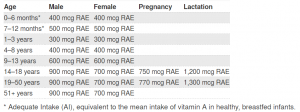
Exhibit 1 Recommended Dietary Allowances for Vitamin A. Retrieved From https://ods.od.nih.gov/factsheets/VitaminA-HealthProfessional/#en2
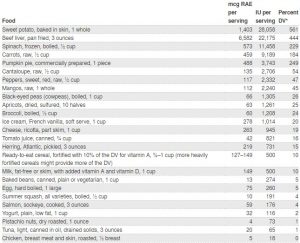
Exhibit 2 Selected Food Sources of Vitamin A. Retrieved from https://ods.od.nih.gov/factsheets/VitaminA-HealthProfessional/#en2
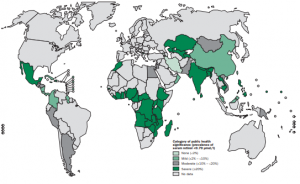
Exhibit 3 Vitamin A deficiency as a public health problem by country 1995-2005: Preschool-age children. Retrieved from http://apps.who.int/iris/bitstream/handle/10665/44110/9789241598019_eng.pdf;jsessionid=44848AEDE9350647C4E3D8F76FF17088?sequence=1
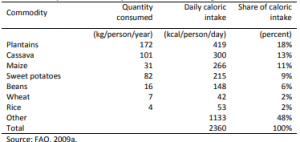
Exhibit 4 Staple foods consumed in Uganda daily and their caloric values. Retrieved from https://ageconsearch.umn.edu/bitstream/58553/2/AAMP_Maputo_25_Uganda_ppr
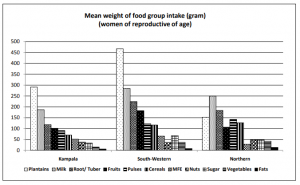
Exhibit 5 Mean weight of food group intake in grams for women of reproductive age. Retrieved from http://www.gainhealth.org/wp-content/uploads/2014/04/44.-Uganda-2008-Food-Consumption-Survey-Report.pdf
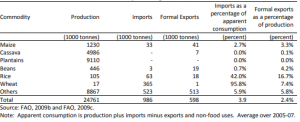
Exhibit 6 Production and trade of food staples in Uganda. Retrieved from https://ageconsearch.umn.edu/bitstream/58553/2/AAMP_Maputo_25_Uganda_ppr
